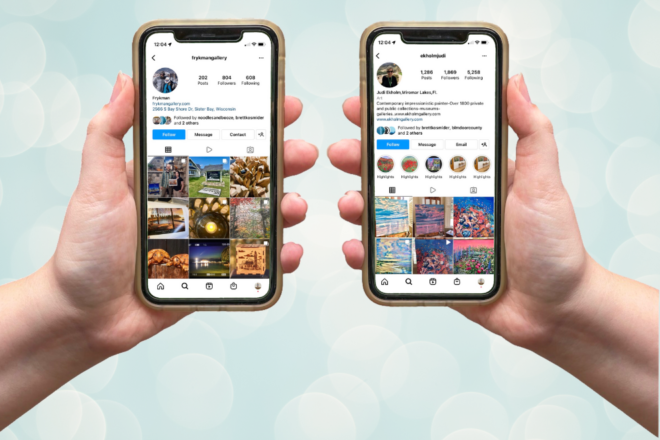Social Media Boosts Artists’ Presence and Sales
- Share
- Tweet
- Pin
- Share

From connecting with current collectors, to reaching new audiences, to boosting sales, social-media platforms have opened up an array of opportunities for artists.
“It’s been fun, and another extension of my work because I see it in another format rather than [on] a gallery wall or in my studio,” said Judi Ekholm, a painter who spends her summers in Fish Creek. “I am a shy person at heart, like a lot of other artists are. Social media has made it easy for me to reach out and connect [with others].”
Her online friends include a master gardener in England who does the Chelsea Flower Show and a woman in Sweden who is a wonderful photographer and has giant poodles. She corresponds with a woman who regularly comments on her work, and she hears from longtime collectors who have discovered her online.
“I do like connecting with people,” Ekholm said. “I got a note yesterday from Beth Meisner at the Miller. I had written her a note and wished her well for their new adventure. She wrote back with her thanks and said she loves the beauty I bring by email and social media.”
Although social media have a reputation in some circles – primarily political – for being negative and even vicious, Ekholm has seen nothing of that.
“Social media is fun,” she said. “I think people like to see things that are positive and happy, so if I can share something that is pleasant, why not?”
Occasionally she posts works in progress.
“I like for people to see what goes on inside my head while I am working and how I work,” she said. “People want to know more, but they don’t always know the right question to ask.”
Ekholm has found that online engagement not only varies by what part of the creative process she posts, but the style of painting she posts. If a painting is more contemporary, for instance, she will get more hits on Instagram. If it’s more traditional, she sees a higher response on Facebook.
But that’s not to say that maintaining an online presence is always easy. Along with its benefits come opportunities to waste time, become frustrated by technology and get distracted from creating art, all of which can foster a love-hate relationship with social media among artists.
Heather Frykman, who operates the Frykman Studio Gallery in Sister Bay with her husband, Luke, said she sometimes wishes she could do without her Facebook and Instagram accounts.
“I don’t like it,” she said. “I would get rid of my account, but I need it to run my business. And to be effective, you have to be consistent with it.”
Investing that time in social media – versus her work – doesn’t always make her feel good. And yet, it recently led to the sale of three gold-framed prints to a customer in Kohler, Wisconsin, who follows the Frykmans’ work online.
Therein lies the double-edged sword that is social media. For all its faults, social media still provides artists with a reach and level of accessibility that their predecessors experienced only through gallery representation.
“Back in the day, before social media was so popular, galleries could sell and represent artists and maybe not have so much competition in sales from the artists themselves,” said Ginnie Cappaert, who runs Cappaert Contemporary in Egg Harbor and shows at Edgewood Orchard Galleries and several other galleries around the country. “Now anybody can find anything or anybody, and it has helped us all get our work out there.”
And although galleries will continue to play an important role in sharing and selling artists’ work, they are now only one of many tools in the artist’s toolbox – a tool that is likely here to stay.

